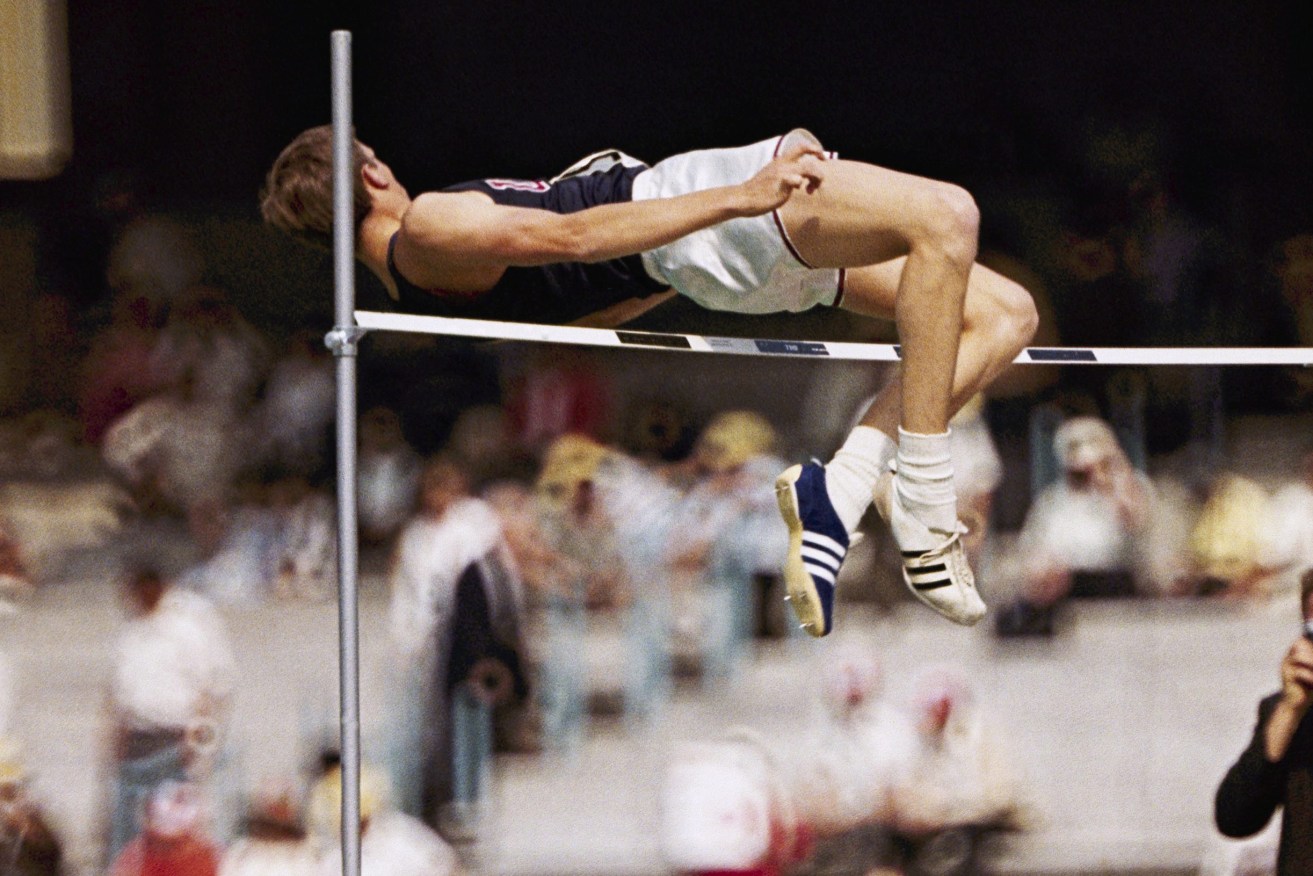The flop that came out on top: Dick Fosbury’s example helped give sport its magic
Sport is all about the rules, until someone comes along who decides it’s time to break some, writes Jim Tucker


Dick Fosbury, the lanky leaper who completely revamped the technical discipline of high jump and won an Olympic gold medal with his “Fosbury Flop,” has died at 76. (AP Photo/AP)
No flop has been more successful than the method of one man to change an entire sporting discipline.
The death this week of the renowned American athlete who pioneered the “Fosbury Flop” was a timely reminder that the only limits in sport are often the handbrakes others want to apply.
The late Dick Fosbury re-imagined the high jump for all. After the frowning faces faded, out went the old scissor kick and straddle techniques and in came his reverse engineering.
It was the late 1960s. Fosbury experimented. He took off jumping backwards and arching his back over the horizontal bar. He changed himself from a modest performer to world class by ignoring traditional methods.
Fad? Not after he won the 1968 Olympic gold medal in Mexico City with a jump that would have cleared towering 2.13m basketballer Andrew Bogut with 11cm to spare.
Fosbury also instantly added a new answer to a sports trivia question…In which sports do you cross the finishing line backwards? There are five in all. You’ll find the answers at the bottom of this story.
Fosbury changed his sport forever. Within a generation, there were only a handful of high jumpers who even contemplated the Olympics with the outdated straddle method.
In the same way, those inventors of the reverse sweep, the switch hit, the ramp shot and Dan Christian’s one-off reverse ramp shot have added dimensions to cricket that those of the Bradman era never envisaged.
Likewise, the slower ball or the mystery ball that the late Shane Warne so wonderfully trumpeted as his off-season project even if he never actually had one. Batters still imagined he had one which was the point of the deception.
These are only single shots and deliveries within a game that is still built around the forward defensive shot, the drive and bowling at the stumps like it was 100 years ago.
Fosbury changed his entire event.
It’s probably closer to the winged keel shaking up the America’s Cup in 1983 when John Bertrand’s yacht, Australia II, sailed to glory on the design adopted by the late Ben Lexcen.
New technology can change everything. Out went Bjorn Borg’s wooden tennis racquets. In came graphite frames and greater power.
The super-suit era in swimming was absurd. Virtually every world record by men and women in togs was obliterated. Wearing full-body polyurethane suits, which artificially aided buoyancy and streamlining through the water, 67 world records were smashed in 2009.
The suits were banned but all those crazy world records from swimming’s 2009 World Championships in Rome stayed in the books.
Swimmers found a way. Back in togs, many of those super-suit records have now been surpassed by swimmers like Queensland’s Ariarne Titmus and Kaylee McKeown.
The likes of Jimmy Connors, Rafael Nadal and Novak Djokovic may have perfected it but it was Italian Beppe Merlo who first used the double-handed backhand in the 1950s. He was derided but he smiled all the way to two semi-finals at the French Championships on clay.
Golf had a certain rhythm to it even when golfers started to hit it longer off the tee with upgraded golf balls and advanced club faces on massive drivers.
It still took Bryson DeChambeau to take the leap to bludgeoning the ball with even greater clubhead speed, a violent swing and a body he built in the gym.
Suddenly, maps weren’t tracing the route to the hole around huge water hazards but over them at a height that put golf balls on the radar of low-flying aircraft.
Augusta National Golf Club will next month unveil its latest concession to the modern power game, a lengthened par five 13th hole for the Masters.
An extra 30m-plus has been added to the iconic hole by pushing back the tee box.
Golf’s ruling bodies this week unveiled a radical new proposal that pros should use a different golf ball at tournaments which would reduce the driving distance of the longest players by 10-15m.
DeChambeau is affronted and he’s not alone.
“I think it’s the most unimaginative, uninspiring, game-cutting thing you could do,” DeChambeau said in Tucson where he’s playing a LIV Golf tournament.
“Everybody wants to see people hit it farther. That’s part of the reason why a lot of people like what I do. It’s part of the reason a lot of people don’t like what I do.”
He’s right about the “like” and “don’t like” divide which is why he’s also one of the reasons that the LIV Golf event in Adelaide next month is close to a sellout.
Breaking the four-minute mile barrier was the great quest in athletics in the 1950s.
The world record had hovered just above the magic mark for nine years before England’s Roger Bannister entered history in 1954.
In modern times, it has been the two-hour marathon. Kenyan wonder Eluid Kipchoge cracked that barely believable barrier in 2019 in Vienna.
There’s a big * beside that one. He had 41 pacemakers in all, an electric timing car keeping him on pace and a course selected because of its long, flat sections protected from the wind.
It’s not in the official world record lists. The exercise was more to do with proving there are no limits.
For those amateur runners out there, Kipchoge was ripping through each mile in about four-and-a-half minutes. Extraordinary.
Fosbury redefined the boundaries of his event.
Rule changes and outside influences are different but have impact in a similar way.
Think of the six-tackle rule being introduced to rugby league in the early 1970s when there had been unlimited tackles for the team in possession years earlier.
Our footy codes are always evolving…the handover rule after six tackles to limit boring scrums and extending the defensive line to 10m to encourage more attack are now taken for granted but an innovator had to think them up first.
Most in the rugby league world had the Dolphins marked for a 0-2 start to their maiden NRL season.
No one told Wayne Bennett and his motivated crew out Redcliffe way because the soaring 2-0 lift-off has invigorated the footy landscape in Queensland.
Like Fosbury, the Dolphins have not been restrained by limits because they have been dreaming big from day one. They haven’t reinvented any methods but they are imbued with admirable traits we all recognise…repeat efforts, experienced leaders, teamwork and chemistry.
What limits?
And those five sports where you find victory hitting the finish line backwards?
Try rowing, tug-of-war, backstroke in swimming, abseiling and high jumping.
JIM TUCKER has specialised in sport, the wider impacts and features for most of his 40 years writing in the media.












